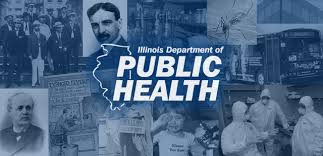The Illinois Department of Public Health (IDPH) reported 10,786 new confirmed and probable cases of coronavirus disease (COVID-19) in Illinois, including 71 deaths since April 1, 2022.
Currently, IDPH is reporting a total of 3,080,436 cases, including 33,465 deaths, in 102 counties in Illinois since the beginning of the pandemic. The age of cases ranges from younger than one to older than 100 years. Since April 1, 2022, laboratories have reported 505,189 specimens tested for a total of 57,898,053 since the beginning of the pandemic.
As of last night, 502 individuals in Illinois were reported to be in the hospital with COVID-19. Of those, 62 patients were in the ICU and 24 patients with COVID-19 were on ventilators.
A total of 21,509,463 vaccines have been administered in Illinois. The seven-day rolling average of vaccines administered daily is 19,926 doses. Since April 1, 2022, 139,480 doses were reported administered in Illinois. Of Illinois’ total population, more than 76% has received at least one COVID-19 vaccine dose, more than 68% of Illinois’ total population is fully vaccinated, and more than 50% is boosted according to data from the Centers for Disease Control and Prevention. Data indicates that the risk of hospitalization and severe outcomes from COVID-19 is much higher for unvaccinated people than for those who are up to date on their vaccinations.
The preliminary seven-day statewide case rate is 85 COVID-19 cases per 100,000 Illinoisans. The preliminary seven-day statewide positivity for cases as a percent of total tests from April 1– 7, 2022 is 2.1%. The preliminary seven-day statewide test positivity from April 1-7, 2022 is 2.3%.
The case rates for COVID-19 are no longer declining and are rising in some areas of the state and have plateaued in other areas over the last 2 weeks. However, hospitalizations and deaths continue to remain low at this point in time. Given that the spread of COVID-19 is not showing signs of further waning, it is critically important that those who continue to be at high risk for serious illness take the following precautions:
• Getting vaccinated and staying up-to-date on recommended booster shots is the best way to protect yourself, your loved ones and friends.
• If you are in an area with rising COVID-19 infections, wear a mask if entering indoors spaces with other people present and consider avoiding large gatherings.
• Stick to well-ventilated areas if you are not wearing a mask indoors around others people.
• If you feel flu-like symptoms, self-isolate and stay home from work; and obtain a test as quickly as possible.
• If you test positive, talk to you provider immediately so you can get COVID-19 treatment within 5 days of starting to feel sick. Also, communicate about the positive result with any persons you have been in close contact within two days of falling sick or testing positive.
• Continue to frequently wash your hands and cover coughs and sneezes.
In addition, on March 29, the Centers for Disease Control and Prevention (CDC) issued updated guidance that authorized a second booster dose for certain segments of the population at least four months after the first booster dose. This applies to adults over 50 years of age, and to immunocompromised individuals over 12 years old. The CDC also recommended a second booster dose with an mRNA vaccine for all those who received the Johnson & Johnson vaccine for both their primary dose and their first booster, four months after their first booster dose. Those who already received an mRNA booster dose after their initial Johnson and Johnson primary vaccine do not need an additional booster unless they are either over the age of 50 years or immunocompromised.
The State of Illinois remains strongly positioned to respond in the event of a new COVID-19 surge. The State stockpile of tests is nearly fully replenished, with more than 1.5 million rapid tests on hand, and a half a million more on the way in the coming weeks. The State has also instructed hospitals, schools, and local health departments to consider their current testing capacity and take all preparations necessary. The State is also in communication with pharmacies and healthcare providers about increasing their inventory of the various FDA-approved treatments in case of another surge. 99.4% of Illinoisans have a pharmacy or clinic providing or dispensing treatment within 20 miles of where they live.
All data are provisional and are subject to change. Additional information and COVID-19 data can be found at https://dph.illinois.gov/covid19.html.
Vaccination is the key to ending this pandemic. To find a COVID-19 vaccination location near you, go to www.vaccines.gov.
The federal government has established a new website that provides an all-purpose toolkit with information on how to obtain masks, treatment, vaccines and testing resources for all areas of the country at: https://www.covid.gov/.
***Report Courtesy of the Illinois Department of Public Health***
















